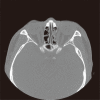Usefulness of a Transconjunctival Approach in the Reconstruction of the Medial Blow-Out Wall Fracture
- PMID: 28913311
- PMCID: PMC5556900
- DOI: 10.7181/acfs.2017.18.2.76
Usefulness of a Transconjunctival Approach in the Reconstruction of the Medial Blow-Out Wall Fracture
Abstract
Background: A transcaruncular approach is typically used for reconstructions of medial wall fractures. However, others reported that a transconjunctival approach was conducive for securing an adequate surgical field of view. In this study, we aimed to examine the extent of repair of medial wall fracture via a transconjunctival approach.
Methods: We retrospectively reviewed the medical records of 50 patients diagnosed as having medial wall fracture via preoperative computed tomography and who underwent surgery between March 2011 and February 2014. The fracture location was defined by dividing each of the anterior-posterior and superior-inferior distances into three compartments.
Results: A transcaruncular approach was used in 7 patients, while the transconjunctival approach was performed in the remaining 43 patients. The transconjunctival approach enabled a relatively broad range of repair that partially included the front and back of the medial wall, and was successful in 86% of the entire study population.
Conclusion: It is known that more than 50% of total cases of the medial wall fracture occur mainly in the middle-middle portion, a majority of which can be reconstructed via a transconjunctival approach. We used a transconjunctival approach in identifying the location of the fracture on image scans except for cases including the fracture of the superior portion in patients with medial wall fracture. If it is possible to identify the location of the fracture, a transconjunctival approach would be an useful method for the reconstruction in that it causes no damages to the lacrimal system and is useful in confirming the overall status of the floor.
Keywords: Ophthalmologic surgical procedure; Orbital fracture; Orbital implants; Reconstructive surgical procedure.
Conflict of interest statement
No potential conflict of interest relevant to this article was reported.
Figures






Similar articles
-
Transcaruncular Approach for Treatment of Medial Wall and Large Orbital Blowout Fractures.Craniomaxillofac Trauma Reconstr. 2016 Mar;9(1):46-54. doi: 10.1055/s-0035-1563390. Epub 2015 Aug 19. Craniomaxillofac Trauma Reconstr. 2016. PMID: 26889348 Free PMC article.
-
Clinical characteristics and treatment of blow-out fracture accompanied by canalicular laceration.J Craniofac Surg. 2012 Sep;23(5):1399-403. doi: 10.1097/SCS.0b013e31825ab043. J Craniofac Surg. 2012. PMID: 22948636
-
Combined transconjunctival and transcaruncular approach for repair of large medial orbital wall fractures.Arch Ophthalmol. 2009 Mar;127(3):291-6. doi: 10.1001/archophthalmol.2009.5. Arch Ophthalmol. 2009. PMID: 19273792
-
Surgical Approaches to Orbital Fractures: A Practical and Systematic Review.Plast Reconstr Surg Glob Open. 2023 May 15;11(5):e4967. doi: 10.1097/GOX.0000000000004967. eCollection 2023 May. Plast Reconstr Surg Glob Open. 2023. PMID: 37197012 Free PMC article. Review.
-
The Revised Direct Transconjunctival Approach to the Orbital Floor.Ophthalmic Plast Reconstr Surg. 2017 Mar/Apr;33(2):93-100. doi: 10.1097/IOP.0000000000000659. Ophthalmic Plast Reconstr Surg. 2017. PMID: 26910230 Review.
Cited by
-
The better surgical timing and approach for orbital fracture: a systematic review and meta-analysis.Ann Transl Med. 2022 May;10(10):564. doi: 10.21037/atm-22-1465. Ann Transl Med. 2022. PMID: 35722414 Free PMC article.
References
-
- Rene C. Update on orbital anatomy. Eye (Lond) 2006;20:1119–1129. - PubMed
-
- Kim S, Helen Lew M, Chung SH, Kook K, Juan Y, Lee S. Repair of medial orbital wall fracture: transcaruncular approach. Orbit. 2005;24:1–9. - PubMed
-
- Ridgway EB, Chen C, Lee BT. Acquired entropion associated with the transconjunctival incision for facial fracture management. J Craniofac Surg. 2009;20:1412–1415. - PubMed
-
- Nowinski D, Messo E, Hedlund A. Treatment of orbital fractures: evaluation of surgical techniques and materials for reconstruction. J Craniofac Surg. 2010;21:1033–1037. - PubMed
-
- Novelli G, Ferrari L, Sozzi D, Mazzoleni F, Bozzetti A. Transconjunctival approach in orbital traumatology: a review of 56 cases. J Craniomaxillofac Surg. 2011;39:266–270. - PubMed
LinkOut - more resources
Full Text Sources
Other Literature Sources

